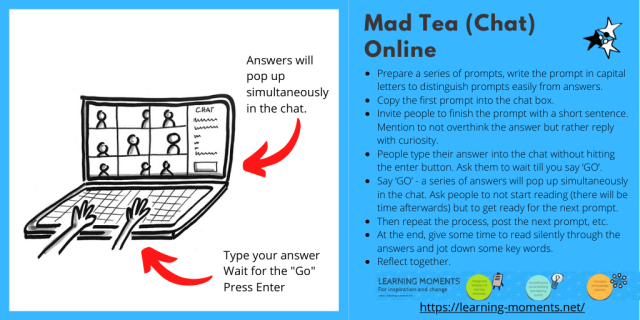
How can we conduct webinars well?
Over the past two years I’ve seen and used many strategies and practices. One unusual technique has appeared, one for getting webinar participants to write in a certain way in a chat box. I found it charming and entertaining, and wanted to note it here as one tool in the videoconference toolbox. I’d also like to see what folks think, especially those who have used it.
The thing is simple. A facilitator asks everyone to start writing in response to a prompt – but not to hit “enter” until a given signal, whereupon everyone hits return simultaneously. The chat box suddenly fills up. A canny facilitator quickly identifies and celebrates fine responses.
What is this technique called? I’ve heard various names, but found no consensus, so I asked around on Twitter and Facebook. I was impressed by the wide range of replies and the imagination they showed. Here are some the responses, with credit to individual respondents, linked when linkable:
1-2-3-Go (Kimberly Sagarin, Thomas Tobin)
321 (“referring to the countdown when everyone types return,” writes Monica Van Dieren, Thomas Tobin)
avalanche (Scott Meyer, Joshua Eyler)
chat blast (Sara Brownell)
chatmospheric river (Megan Barker)
chatslam (Brett McCollum)
chatstorm (Stephanie Doscher, Naomi Uman)
chatterfall (Bethanie Morrison, Torrey Trust, Melissa Beers, Terry Greene)
chatterfloat (Autumm Caines)
everybody writes (Neil Mosley)
hot lava (“there’s a volcano of ideas brewing and they all erupt in the chat flowing like hot lava,” according to Christina Ragan)
infinite monkeying (Ken Usman-Smith)
Mad Tea. Learning Moments has a graphic about it, and they sourced the term and concept to Liberating Structures: (The Center for Project-Based Learning at WPI)
popcorn (Karen Bellnier)
ready set go question (Derek Bruff)
think-share (Melissa Wong)
waterfall (Joshua Eyler, Robert Talbert, Jessica McKee, Ernie Perez, Clint Lalonde, Thomas Tobin). I also wondered about the Spanish language equivalent.
word cascade (Trevor Griffey)
Zoomchatchaos (Lisa Beach)
There may well be other names.
Besides the name, how do you use this chat-chaos-storm practice? To be clear, I haven’t used it myself as a facilitator or presenter.
Debra Berke describes her method of hosting one such blast, then “ask[ing students] to note similarities and differences in responses.”
Sara Brownell advises “asking folks for a limited number of responses (yes or no, a/b/c/d) so you can quickly skim.” [I think this means a limited number of words in each response.]
Melissa Wong describes her method:
I explain that I want them to think about their answer, but not put it in chat until we’ve all had a few minutes to think without distraction. Then I wait 1-2 minutes (depending on the question, maybe more), then ask people to go ahead and share their idea in the chat.
— Melissa Wong (@LISafterclass) June 22, 2022
Candace Sleeman uses it for polling, a bit like Sara Brownell’s practice:
Aye, nay or abstain on a board vote
— Candace Sleeman (@candace9839) June 24, 2022
So if every participant behaves, and nobody jumps the gun, the result is something like a secret ballot, at least until all entries appear.
Now, I said I appreciated the waterfall etc., but not everyone does, which is one reason I wanted to blog about it. Here’s Jim Luke’s critique:
I call it an utter waste of time, esp if there’s more than maybe 5 ppl in the Zoom. It feels like somehow dialogue is happening, but it’s not. It’s also horrible for ADHD’s.
— Jim Luke is getting into good, necessary trouble (@econproph) June 22, 2022
Honestly, it’s distraction & a bad practice. It’s like everybody has forgotten principles of good multimedia practice (Richard Mayer) from 15-20 yrs ago. Just because it’s fun for presenter doesn’t mean it’s viable focused learning. Too many channels open at once! Def not UDL.
— Jim Luke is getting into good, necessary trouble (@econproph) June 23, 2022
Joe Murphy observes that a chatblast can be more of a stimulus than a real discussion. Joe also compares chatterfall to word clouds.
lmockford points out that poor bandwidth can wreck any such exercise.
Reflecting on these pro- and anti-chatchaostormfall views, I think we can see some emerging practices for certain practitioners and situations. It can work as a quick poll, as a discussion prompt, and as a way to shake up or invigorate a quiet group. Doing so well means avoiding the problems pointed out above.
Have you experienced this, either as facilitator or participant?
Related

